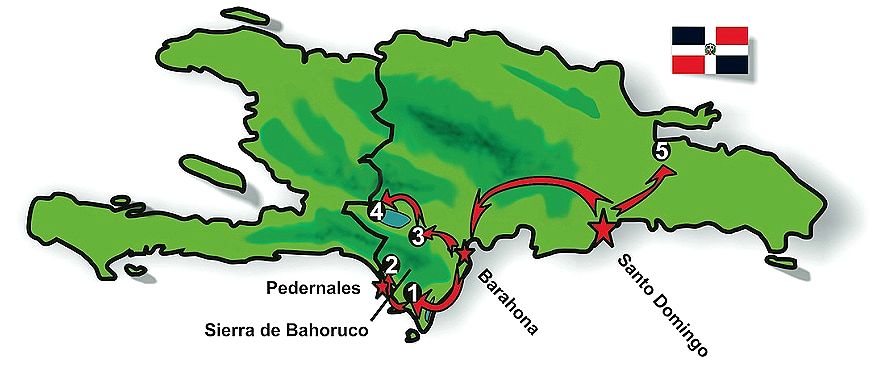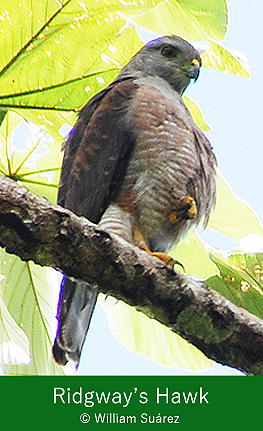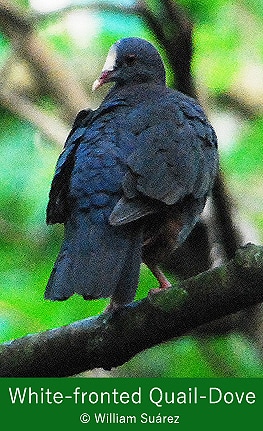<< DOMINICAN REPUBLIC (HISPANIOLA ISLAND)BIRDING
Our birding tours to the Dominican Republic offer the possibility to see and understand why Hispaniola is the most interesting island for birdwatching in the Caribbean!
Quick Info Literature & Audio Photo Gallery Bird Checklist COVID-19
|
Hispaniola ("Quisqueya") is east of the Cuban archipelago, west of Puerto Rico, and northeast of Jamaica. It is the second largest land mass in the Caribbean and is in the center of the chain formed by the Greater Antillean islands. The Dominican Republic occupies the eastern two-thirds of the island, whereas the western third is occupied by the Republic of Haiti. Four mountain ranges dominate the topography, with Pico Duarte being the highest peak in insular Caribbean (10,164 ft/3,098 m). The longest rivers in the West Indies originate in these mountain ranges. The Caribbean's largest lake (Lago Enriquillo) is also present there.
Three endemic West Indian bird families can be found only in Hispaniola: Dulidae, Calyptophilidae (Chat-Tanagers) and Phaenicophilidae (Hispaniolan Tanagers). Dulidae is represented by the enigmatic and monotypic Palmchat (Dulus dominicus), the national bird of the Dominican Republic. This country is also home of many other ancient and very interesting birds such as the Least Pauraque (Siphonorhis brewsteri), the Antillean Piculet (Nesoctites micromegas), and the Flat-billed Vireo (Vireo nanus). The Hispaniolan avifauna is composed of about 313 species, of which 33 or more (variable, depending on the authority) are endemic. About 140 species are permanent residents and at least 136 are wintering migrants from North America (see Bird Checklist). One of the critically endangered species is the endemic Ridgway's Hawk (Buteo ridgwayi), which can be found at Los Haitises National Park, north of the capital city of Santo Domingo, and in a few other localities. Our birding programs in the Dominican Republic (see map) visit localities with the highest importance for biodiversity and richness of avifauna, both in terms of endemism and species numbers, covering most habitats. We will be birding in pine and cloud forests from high elevations in mountain ranges, to foothills, and we will also explore lowlands, deserts, lakes, mangroves, and coastlines. Some early morning starts are necessary and there is a night (or more) birding session as well.
Dominican Republic |
Main Localities: 1) El Aceitillar, 2) Los Arroyos, 3) Rabo de Gato, 4) Lago Enriquillo, 5) Los Haitises
Main Localities: 1) El Aceitillar, 2) Los Arroyos, 3) Rabo de Gato, 4) Lago Enriquillo, 5) Los Haitises
DAY 1: Birding Tour to the Dominican Republic (Hispaniola Island): Welcome day!Arrival to Santo Domingo and transfer from International Airport Las Americas (SDQ). A $10 tourist card must be purchased upon your arrival. We will be waiting for you at the airport for your transportation to the hotel, where members of the group will check into their reserved rooms. At 6:00 p.m. participants will meet the leader in the lobby for a welcome meeting and discussion of the birding trip plans before dinner. Night in Santo Domingo.
DAY 2: Jardín Botánico Nacional & BarahonaIn the morning we will explore the grounds of the National Botanical Garden "Dr. Rafael M. Moscoso", located in the capital city of Santo Domingo. Within this park (494 ac/200 ha) we will have a convenient "first contact" with the Hispaniolan birds as a starting point for the study of the remaining island avifauna. As is characteristic of botanical gardens, the diversity of plants makes this place, in the urban heart of Santo Domingo, a perfect refuge for local birds. It is possible to find common endemic species, subspecies, some West Indian specialties, as well as other birds in this garden including the West Indian Whistling-Duck, Least Grebe, Common Gallinule, Limpkin, Hispaniolan Lizard-Cuckoo, Antillean Palm-Swift, Hispaniolan Mango, Vervain Hummingbird —the second smallest species of bird in the world— Hispaniolan Woodpecker, Hispaniolan Parakeet, Stolid Flycatcher, Red-legged Thrush, Palmchat, Bananaquit, Black-crowned Palm-Tanager, Greater Antillean Grackle, several migratory warblers, and more.
After our first birding session in Hispaniola, we will drive to the southwest for about 3-4 hours to our hotel in the Barahona Peninsula. Lunch will be in Santo Domingo or en route to Barahona. From our headquarters in Barahona, we will begin to explore the southwestern region of the Dominican Republic, especially Sierra de Bahoruco National Park (302,674 ac/ 112,488 ha), reaching an altitude of 7,766 ft (2,367 m). This is the southernmost mountain range of Hispaniola and where the majority of endemic birds can be found in the Dominican Republic. Night in Barahona. DAY 3: El Cachote & Cabo RojoOur birding explorations will begin with an early departure to El Cachote, in Sierra de Bahoruco Oriental (Eastern Bahoruco). The target bird here is the Eastern Chat-Tanager. On this and the following birding days, we will be departing for the field before dawn, due to the rather slow and difficult drives through some localities within the region. Predawn searches, for some endemics such as the Least Pauraque and Greater Antillean Nightjar, will be conducted if necessary.
After lunch, we will visit the lagoons and wetlands of Cabo Rojo, a locality near the southern slope of Sierra de Bahoruco. Possible species here are West Indian Whistling-Duck, White-cheeked Pintail, Blue-winged Teal, Magnificent Frigatebird, Brown Pelican, some egrets, White Ibis, Roseate Spoonbill, Clapper Rail, American Coot, Black-necked Stilt, Greater and Lesser Yellowlegs, Royal Tern, White-necked Crow, and Yellow Warbler, among others. Night in Pedernales. DAY 4: Los Arroyos Cloud Forest & El AceitillarAfter an early morning departure, we will drive north near the Haitian border to Los Arroyos, which is also part of the Bahoruco National Park. It is difficult and time consuming to reach this locality because of the poor unpaved road conditions, and it also is necessary to reach the forest during the most active period for our target bird, the endemic and endangered La Selle Thrush. Arriving before daybreak, and also en route, we may be able to see the Hispaniolan endemic subspecies of the Burrowing Owl and the Hispaniolan Nightjar. Other species that can be found at Los Arroyos include the Hispaniolan Trogon, Narrow-billed Tody, Greater Antillean Elaenia, Hispaniolan Pewee, Loggerhead Kingbird, Golden Swallow, Rufous-throated Solitaire, Bicknell's Thrush, White-winged Warbler, Green-tailed Warbler, Western Chat-Tanager, Hispaniolan Spindalis, Antillean Siskin, and more.
After lunch our next destination will be El Aceitillar, which is located on the southern slope of Sierra de Bahoruco. It is a location along the Alcoa road, used for mining and extraction of bauxite deposits. By driving this excellent and easy road we will reach the top of the mountain. The transition of the vegetation (15 natural vegetation zones exist in Bahoruco National Park) during our drive up will be quite noticeable, beginning with thorn-scrub habitat, then deciduous woodland, humid montane broadleaf forest, and ending with a cover of pine forest at the top. These changes in habitats obviously give us an opportunity to observe changes in the bird species occupying their respective niches. We will begin our stratified altitudinal search of the avifauna as we move upslope. Possible species to be observed during this afternoon are Plain Pigeon, Hispaniolan Emerald, Hispaniolan Trogon, Broad-billed and Narrow-billed todies, Antillean Piculet, Hispaniolan Parakeet, Hispaniolan Parrot, Greater Antillean Elaenia, Hispaniolan Pewee, Flat-billed Vireo, Hispaniolan Palm-Crow, Golden Swallow, Rufous-throated Solitaire, Pine Warbler, Green-tailed Warbler, Hispaniolan Spindalis, Hispaniolan Euphonia, Hispaniolan Crossbill, Antillean Siskin, and others. Night in Barahona. DAY 5: Rabo de Gato trail & Lago EnriquilloThis morning our birding session will be conducted around the town of Puerto Escondido, at the Rabo de Gato trail. This riparian habitat will provide us with good views of some endemic species that are difficult to find in other localities. Birds to be encountered here are White-fronted, Key West, and Ruddy quail-doves, Bay-breasted Cuckoo, Hispaniolan Emerald, Hispaniolan Trogon, Broad-billed and Narrow-billed todies, Antillean Piculet, Hispaniolan Parakeet, Olive-throated Parakeet, Hispaniolan Parrot, Greater Antillean Elaenia, Hispaniolan Pewee, Stolid Flycatcher, Flat-billed Vireo, White-necked Crow, Golden Swallow, Rufous-throated Solitaire, Green-tailed Warbler, Hispaniolan Spindalis, Yellow-faced Grassquit, Greater Antillean Bullfinch, Hispaniolan Euphonia, Antillean Siskin, and others.
After lunch, we will visit Lago Enriquillo, the largest lake in the Caribbean region, lying 130 ft (40 m) below sea level. Possible species there include West Indian Whistling-Duck, American Flamingo, Plain Pigeon, White-winged Dove, Hispaniolan Parakeet, Hispaniolan Parrot, Mangrove Cuckoo, Hispaniolan Lizard-Cuckoo, Burrowing Owl, Antillean Palm-Swift, Hispaniolan Mango, Broad-billed Tody, Antillean Piculet, Hispaniolan Woodpecker, Stolid Flycatcher, Hispaniolan Palm-Crow, Black-crowned Palm-Tanager, Hispaniolan Oriole, and Village Weaver. After birding in the lake we will return to the capital city. Night in Santo Domingo. DAY 6: Los Haitises National ParkIn the morning we will be departing to explore Los Haitises National Park, situated on Samaná Bay on the northeast coast of the Dominican Republic. This is one of the largest and most densely vegetated parks in this country and a region in which it is possible to observe the endemic and endangered raptor, Ridgway's Hawk. This park includes a variety of habitats such as moist broadleaf forest on limestone karst, secondary forest, and mangroves. Rugged, closely spaced limestone hills ("mogotes") covered with dense vegetation occur in the park.
Today the Ridgway's Hawk is confined to remote and isolated localities. The cause is a long period of human persecution and destruction of its natural habitat that began with the Spanish discovery of the island and which accelerated during the last century. Our search for this raptor, the rarest member of its genus in the world, will be conducted in the afternoon and in the morning of the following day. This species seems to be closely related to the Red-shouldered Hawk, now confined to North America. Populations of the latter species existed in Cuba (and in the Bahamas) during the late Pleistocene (Glacial Age) and are thought to be related to the origin of the Hispaniolan bird. Other possible species to be observed during this exploration and en route to the park include the Red-tailed Hawk, Limpkin, White-crowned Pigeon, Plain Pigeon, Ruddy Quail-Dove, Mangrove and Hispaniolan Lizard-Cuckoos, Ashy-faced Owl, Antillean Palm-Swift, Hispaniolan Mango, Vervain Hummingbird, Hispaniolan Emerald, Broad-billed Tody, Antillean Piculet, Hispaniolan Woodpecker, Hispaniolan Pewee, Stolid Flycatcher, White-necked Crow, Palmchat, Black-crowned Palm Tanager, Greater Antillean Grackle, Hispaniolan Oriole, migratory warblers and some introduced species. Night in Caño Hondo. DAY 7: Los Haitises National Park & Santo DomingoAt Los Haitises National Park we will be conducting our last birding exploration in the Dominican Republic. After our morning session and lunch at the hotel we will drive to the capital city of Santo Domingo. After check-in at the hotel and some time to relax, those who want to join the leader in the late afternoon can visit colonies of Hispaniolan Parakeets that roost on buildings in the city. Night in Santo Domingo.
DAY 8: Departure & "Hasta Luego a Quisqueya" (Good-bye to the Dominican Republic)Day of transfer from the hotel to International Airport Las Americas (SDQ) for departures of the members of the group.
|
Alterations in Tour Itineraries: Owing to a variety of circumstances, a planned itinerary as appears on this website, can be changed or modified locally by the leader to accommodate particular weather conditions, bird activity, human disturbances, unexpected situations, or any other reasons considered by the leader. WILLIAM SUAREZ BIRDING TOURS reserves the right to change any itinerary.


















